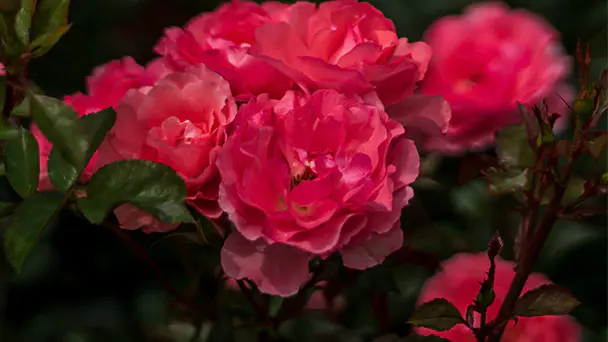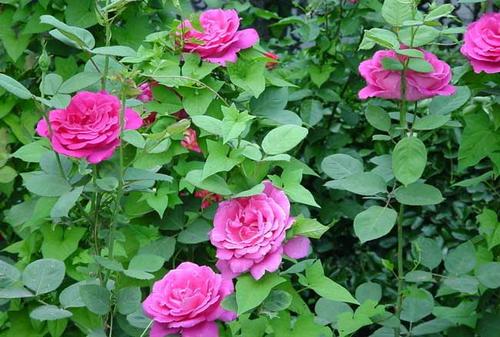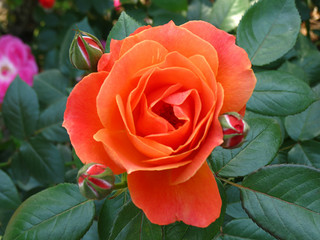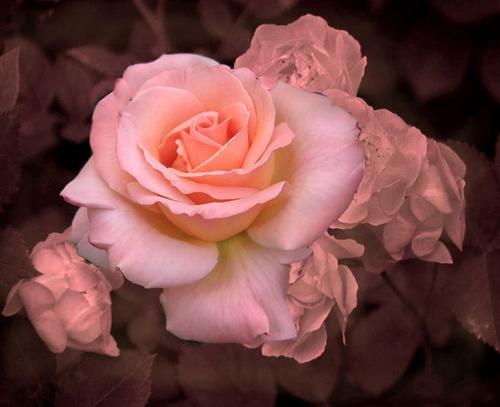Rosa Chinensis (China Rose): Plant Growing & Care Tips
Written by Maggie
Dec 14 2022

For Rosa chinensis Jacq, commonly called China rose, Chinese hibiscus, Hawaiian hibiscus, rose mallow, etc, if you first prepare suitable mud pots for potting, you must also use garden soil, garbage soil, and husked ash as the substrate. After propagating, you need to care for Rosa Chinensis Jacq carefully. Generally, the temperature should be maintained at 18-20°C, and the temperature can be controlled at 5 in winter. Above ℃, it is necessary to provide plenty of water and nutrients to it at ordinary times, especially during the flowering period, which can be cut to propagate after trimming.
Growing a China rose at home entails planning an adequate watering schedule and using the right fertilizer. We can grow Rosa Chinensis in fertile, moist, well-drained soil in full sun or partial shade.

Rosa Chinensis Quick Info
| Botanical/Scientific Name | Rosa Chinensis |
| Common Name | China Rose |
| Flower Color | Red, pink, white or purple petals |
| When to Grow | Grow in September to March |
| Bloom Time | The flowering time ranges in China from April to September |
| Uses | Treating arthritis, boils, cough, haemuturia and rheumatoid joint pains |
| Origin | Southwest China in Guizhou, Hubei, and Sichuan Provinces |
| Light Requirements | Full sun or partial shade |
| Soil Care | Well-drained soil |
| Temperature Care | Approximately 60° - 75°F (15° - 24°C) |
| Humidity Care | Moist |
| Watering | Water thoroughly until the soil is wet and a small puddle forms around the tree |
| Pruning Care | Prune lightly or back by up to 1/3 |
| Fertilizer Care | Organic and inorganic fertilizers |
| Propagation | Propagate china roses from cuttings |
| Toxic | Still unknown |
When to Plant Rosa Chinensis
After the cold winter, the temperature began to rise gradually. At this time, rosa chinensis can be cultivated. When cultivating Rosa chinensis, we must give it fluffy and well-drained soil for growth, and we should also put it in a place with plenty of light for maintenance.
When does Rosa Chinensis Bloom
Rosa Chinensis will continue to open from April to November every year. Its flowers are rich in color, including red, white and yellow, which has high ornamental value. When propagating Rosa chinensis at the flowering stage, it is necessary to place it in a bright place to promote the light cooperation of plants. After the flowering stage of Rosa chinensis, We will cut off the withered flowers and yellow branches and leaves.
Rosa Chinensis Care in Detail
Rosa Chinensis Light Requirements
Rosa chinensis is a plant that likes light very much. It needs a lot of light. We suggest full-time light, but some varieties. The demand for light is not very strong, but it can't be without light. At least Rosa chinensis can grow well in more than half a day. Better light can be conducive to plant photosynthesis, promote root growth, flowering and plant opening, and promote plant sprouting.
For the roses of small seedlings, medium seedlings and large seedlings, we suggest that they should be taken all day. Some varieties need proper shade in summer, and try to give better light. Roses are not afraid of sun exposure, so you don't need shade if you don't need to see flowers in hot weather in summer. Of course, for some Rosa chinensis varieties, because the flowers are not sun resistant, we can provide an appropriate amount of shade, which can increase the viewing cycle of flowers.
Read More: How to Care for China Rose Leaves Yellowing or Buds Falling
Rosa Chinensis Humidity
Rosa Chinensis likes moist soil and is afraid of drought or ponding. Therefore, it must be ensured that the soil is loose, the drainage is good, and there is a certain role of water and fertilizer conservation. The selection of Rosa chinensis flowerpot does not need to be very fancy. It can be a permeable and breathable ordinary mud basin. Our new mud basin can be soaked with water before use.
Rosa Chinensis Repotting
Rosa chinesis repotting is divided into two situations. One is to buy seedlings from yellow soil, which should be paid attention to when changing pots, and the other is to plant them in nutritious soil. Rosa chinesis repotting is much simpler. For roses planted in yellow soil, remember to wash roots and change pots without mud bumps, After planting, the drying speed of mud pimples is very slow, and after the yellow mud is completely dry, you go to the side and fill it with nutrient soil. If you water, the yellow mud pimples can't absorb water. The nutrient soil has been completely wet, which will cause the internal dry and external wet situation, which is absolutely bad. Therefore, you must thoroughly wash the roots and change the basin. We can soak the yellow mud in water. After soaking the yellow mud, we can plant it with new nutrient soil. After planting, we must water it, and we must pour some rooting liquid and carbendazim into it. If the branches are too long, trim them properly, and then put them in a place with good ventilation and a little scattered light. Spray water on them every morning and evening to moisturize them, so that the leaves can absorb some water. In this way, Rosa chinensis can recover completely after last week.
Rosa Chinensis Soil Care
If before growing potted Rosa chinensis Jacq, you first need to prepare a clay pot of appropriate size, with drainage holes at the bottom, and usually use garden soil, garbage soil, and hull ash according to 5:3:2. Mix the soil with the ratio of, and change the pot every two years, and the potting container needs to be gradually enlarged.
Rosa Chinensis Temperature Care
Generally, when we grow and care for Rosa chinensis Jacq, it is best to maintain the temperature at 18-20℃. Usually, it needs to be placed in the sun for curing, but in summer, it needs to be watered and cooled. In winter, rosa chinensis jacq not only needs enough light, and the temperature must be controlled above 5°C to make more flowers bloom during the flowering period.
Rosa Chinensis Watering & Fertilizer Care
Generally, Rosa chinensis Jacq grows vigorously in spring and autumn. We need to water it every 2 to 4 days. We need to irrigate the soil every time. When the climate gradually warms up, we can also increase the watering amount. To do a good job of drainage, generally apply organic fertilizer every half a month during the seedling period, and apply nitrogen fertilizer and a small amount of phosphorus and potassium fertilizer every 10 days during the growth period.
Rosa Chinensis Pruning Care
Rosa chinensis Jacq needs to be properly pruned every year. When new branches of Rosa chinensis Jacq grow to 15-20cm each spring, they need to be pruned to 3~5cm, and then useless branches are cut off. This can resist the growth of Rosa chinensis Jacq, promotes the germination of side buds and makes them bloom beautiful flowers, which increases the ornamental value of Rosa chinensis Jacq.

Cleaning Pruning
Unlike other species, the Two prunings are required for the rose of China. The first is the pruning cleaning and it consists of eliminating from the plant all those that are not useful for its development.
It can be done in the winter and allows for the removal of suckers, also known as out-of-control branches, crossed, broken, or poorly oriented branches, as well as dead, diseased, or dry branches. It can also get rid of sprouts that have grown from the roots.
During this pruning, the flowers, ripe fruit, and sprouts that would otherwise grow into a branch of the plant will also be removed.
Flowering Pruning
The second pruning the China Rose it occurs in late winter in warm climates or early spring in temperate climates. This pruning aims to increase flowering.
To perform the flowering pruning, Because the main branches and the bush's central structure must be preserved in order for the buds that will eventually give rise to the flowers to sprout from them, you must be quite severe in your pruning.
The buds for the china rose or Hibiscus are born on branches that have grown in the same year.
Rosa Chinensis Propagation
Propagating Rosa Chinensis from Seeds
Rosa chinensis likes loose and fertile soil. Some gravel soil can be added to the soil to increase the air permeability of the soil. Soaking the prepared soil with carbendazim solution for disinfection can effectively reduce the breeding of bacteria and effectively improve the germination survival rate of seeds.
A low-temperature environment shall be selected for transplanting Rosa chinensis seedlings, the temperature shall be controlled between 5 ~ 10 ℃, and the seeds shall be evenly sown in the soil according to the spacing of 3cm. Cover the soil surface with a layer of river sand and water it to ensure the moisture of the soil. After one month, it can take root and sprout and grow seedlings.
Read More: How to Grow China Rose from Seeds
How to Propagate Rosa Chinensis from Cuttings
Rosa chinensis Jacq needs to be pruned and shaped in spring and autumn every year. After pruning, it must be sprayed with medicine. You can select strong branches from the branches left after pruning, and then dispose of the upper leaves of the branches, and then insert them into suitable ones. In the growing soil, it can be carefully maintained under astigmatism.
Read More: How to Propagate China Rose
Rosa Chinensis Mulch Care
Rosa chinensis Jacq hates competition, so both you love to hoe, and you hoe each and every two weeks, or you mulch twice a 12 months in order to have 3-4 cm of straw or timber on the ground. Mulch with what you have with a sensible quantity: a little (very very little) bit of grass cuttings, dry leaves, or even compost, no longer but utterly decomposed earlier than winter. The significance is to cover.
Rosa Chinensis Disease & Pests Control
| Slug moth | They mainly feed on leaves in the high temperature season. Prevention and control methods: once found, should be immediately with 90% trichlorfon crystal 800 times the liquid spray, or with 2.5% fenfenothrin emulsion 1500 spray. |
| Scale insect | There are mainly white rotunda scale, Japanese tortoise wax scale, red wax scale, brown soft wax scale, blowing cotton scale, chaff plate shield scale, snake eye scale, etc., which are characterized by their harmful characteristics of sucking SAP of tender stems and young leaves of Chinese rose, leading to poor plant growth, mainly caused by high temperature, high humidity, poor ventilation and poor light. Prevention and control method: in its nymphs hatching peak period, with 25% of the dipterin wettable powder 2000 times liquid spray kill. |
| Aphis | They are mainly chinese rose tube aphid, peach aphid, etc., which suck the juice of the tender organs of the plant, harm the tender stems, young leaves, flower buds, etc., and seriously affect the growth and flowering of the plant. Prevention and control method: use 10% imidacloprid wettable powder 2000 times liquid spray kill. |
| Arge pagans Panzer | More in the larval stage, dozens or hundreds of clusters of harm, in a short time can eat up the tender leaves of the plant, leaving only a few main veins, serious harm to the normal growth of the plant. Prevention and control method: a small amount of potted plants, but at the beginning of the appearance, picking a large number of larva gathered leaves, its trample dead. A large number of available 75% phoxim emulsion 4000 times liquid spray kill. |
| Tetranychus cinnabarinus | It is mainly verdant cockchafer, black velvet cockchafer, white star flower cockchafer, small blue and white cockchafer, often gnaw with adult insect feed new leaf, tender tip and bud, the growth that affects the plant seriously and blossom. Prevention and control method: use the false mortality of the adult insect, in the evening to kill and shake down. The phototaxis of adults were used to trap and kill them with black light. When the adult insects feed on the harm, they are sprayed with 50% malathion emulsion 1000 times liquid. |
| Borer | China rose drill for the larva of the stem wasp, in the stem cavities, drill into the stem chewing, resulting in branches broken, the upper dead. The larvae are white, with a yellowish head and a body length of about 15-17 mm. The adult has wings, black body, yellow abdomen on both sides. Chrysalis vermilion. Usually 1 generation occurs every year, in the stem of the pupation overwintering, as a greater harm to the pests. |
China Rose Toxicity
China roses are not poisonous, and rose hips can even be used to make cakes, perfume, and a variety of other products. When picking them, just be mindful of the thorns!
Rosa Chinensis Benefits
Rosa chinensis is an ornamental flower with the characteristics of fragrant color and long flowering period. It is not only widely used in landscaping, but also very common in the layout of flower beds and courtyards in gardens. It can also be appreciated as a bonsai in families. In addition, the production of cut flowers, flower baskets and bouquets is also a common use of Rosa chinensis. Rosa chinensis has the function of a greening environment. The characteristics of shrubs enable it to form a unique shape such as a continuous flower hedge, flower wall and flower screen.
Rosa chinensis is not only for people to enjoy in gardens and in various places, but also plays a dual role in greening the environment. The characteristics of shrubs enable them to form unique shapes such as continuous flower hedgerows, flower walls and flower screens. Growing in organs, schools, urban squares and residential areas, they can effectively purify the surrounding air and greatly reduce the noise pollution in nearby areas. They also have a good mitigation effect on the greenhouse effect in the City in summer.
Why is My China Rose Not Blooming?
Sunlight and nutrients must be sufficient for the China rose to bloom. It rarely develops flower buds in the absence of enough light. It usually lacks nutrients if it has buds but does not bloom normally. To correct this, granular and foliar fertilizers can be applied simultaneously. To concentrate nutrition and prevent overconsumption of nutrients, it is also possible to remove smaller buds from the same branch, leaving only one or two of the largest buds. Some varieties also only bloom in the spring, while others also bloom in the fall and even in the summer. So, you should pay attention to the varieties you planted.Why Do My China Rose Leaves Turn Yellow?
There are numerous reasons why leaves might turn yellow. There is no need to be concerned if it is a natural occurrence. It might also be the result of improper fertilization, such as using too much fertilizer concentration. this requires a lot of water to irrigate and wash the flower soil or may require replacing it with new soil to alleviate the problem. The soil can be slightly loosened to speed up water loss if the yellowing is caused by excessive rainfall, excessive soil moisture, or root system damage. The leaves may also be burned by too much sunlight. In this situation, you must first remove the burned yellow leaves from the plant before giving it the right amount of shade. You could hang a shade net over roses that are planted in the garden or move a potted rose to a shady spot.
Latest Updated
- Benefits of Bugleweed - 7 Science-backed Health Benefits
- Bugleweed Dangers & Side Effects - Is It Poisonous?
- How to Plant Evergreen Trees - What You Should Know
- When to Plant Evergreens - Grow Guide for Evergreen Trees
- 12 Wonderful Evergreen Shrubs for Your Garden
- 12 Popular Evergreen Plants with Pictures for Beginners
- When And How To Prune A Lilac Bush Like a Pro
- How to Grow & Care for Lilac Vine (Hardenbergia Violacea)
- Japanese Lilac Tree (Syringa Reticulata) Care & Propagation Guide
- Shumard Oak Pros and Cons - What to Know
Popular Articles
- Winter maintenance of Antirrhinum Majus
- How to Grow Terminalia Mantaly Tree
- How to Grow and Care for Crossostephium Chinense
- How to grow Antirrhinum Majus in spring
- Peristeria Elata (Dove Orchid) Profile: Info & Care Guide
- Underwatered Snake Plant (Sansevieria Trifasciata) - Signs And How To Fix
- How to Care for Brazilian Jasmine Plant (Mandevilla Sanderi)
- How to Grow & Care for Graptopetalum Purple Delight in Summer
- Rosa Chinensis (China Rose): Plant Growing & Care Tips
- How to Care for Baby Sun Rose (Aptenia Cordifolia)